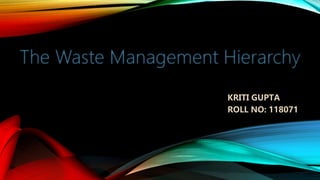waste management hierarchy system
- 1. KRITI GUPTA ROLL NO: 118071
- 2. •Advantages and benefits • Saving energy. • Reducing pollutants. • Conserve valuable resources. • Stimulate the development of green technologies. • Prevent emissions of harmful greenhouse gas emissions.
- 5. 1. Pollution Prevention (𝑃2) is any practice that reduces, eliminates, or prevents pollution at its source, also known as "source reduction.“ Resource conservation Using less energy
- 6. Specific pollution prevention approaches Pollution prevention approaches can be applied to all potential and actual pollution-generating activities, including those found in the energy, agriculture, federal, consumer and industrial sectors. Prevention practices are essential for preserving wetlands, groundwater sources and other critical ecosystems - areas in which we especially want to stop pollution before it begins. In the energy sector, pollution prevention can reduce environmental damages from extraction, processing, transport and combustion of fuels. Pollution prevention approaches include: increasing efficiency in energy use; use of environmentally benign fuel sources.
- 7. 𝑷 𝟐 in different fields In the industrial sector, examples of P2 practices include: 1. Modifying a production process to produce less waste 2. Using non-toxic or less toxic chemicals as cleaners, degreasers and other maintenance chemicals 3. Implementing water and energy conservation practices 4. Reusing materials such as drums and pallets rather than disposing of them as waste
- 8. In the agricultural sector, pollution prevention approaches include: 1. Reducing the use of water and chemical inputs; 2. Adoption of less environmentally harmful pesticides or cultivation of crop strains with natural resistance to pests; 3. Protection of sensitive areas. In homes and schools examples of P2 practices include: 1. Using reusable water bottles instead of throw-aways 2. Automatically turning off lights when not in use 3. Repairing leaky faucets and hoses 4. Switching to "green" cleaners
- 9. 2. RE-USE
- 10. 2. RE-USE Reuse is another effective Solid waste management strategy, in which the waste is not allowed to enter into the disposal system. Reuse can be defined as using a waste product without further transformation and without changing its shape or original nature. This process helps in minimizing the amount of wastes produced as end product, saves the natural resources and reduces the costs associated with the production and manufacturing.
- 11. Examples of industrial reuse A welding plant did not discard its empty wire spools , but returns them to the suppliers, who reuses them Engine parts from vehicle engines re refurbished and reused An oil refinery refine motor vehicle oil for reuse.
- 12. Examples of reuse Old jars and pots: Old jars and pots can be used to store items in kitchen. They can also be used to store loose items together such as computer wires. Tyres: Old tyres can either be sent to recycling station or can be used to make tyre-swing. Used wood: Used wood can be used as firewood or can be used woodcrafts. Newspaper: Old newspapers can be used to pack items when you’re planning to move to another home or store old items.
- 13. Some example of best out of waste (Re-use) Mini Shoe reck made from amazon boxes Desk organiser made from Haldiram sweet box Pen pot stand made from geometry box outer cover packing
- 14. 1. Old books: Your old books can be used by poor children or can be donated to public libraries. 2. Old clothes: Your unwanted clothes can be used by street children or can be donated to charity institutions. 3. Old electric equipment: Old electric equipment can be donated to schools or NGO’s so that they can use them. 4. Rechargeable batteries: Rechargeable batteries can be used again and again and helps to reduce unnecessary wastage as opposed to regular batteries.
- 15. 3. RECYCLING
- 16. 3. RECYCLING In the recycling strategy, the waste materials are implemented in the production of a new product. In this process, the waste materials of various forms are collected and then processed. Recycle: to convert materials/waste into reusable material Landfills are full of items that could be recycled. Recycling puts objects through a process that allows them to be used again.
- 17. BENEFITS OF Recycle • reduces the need for land filling and incineration • prevents pollution • saves energy • decreases emissions of greenhouse gases that contribute to global climate change • conserves natural resources • helps sustain the environment for future generations
- 22. 4. TREATMENT
- 23. WASTE TREATMENT When a solid is cant be reused or recycled the third step treatment is used. Reasons to treat solid waste or a pollutant 1. Reduce its volume 2. Reduce its toxicity
- 24. TREATMENT METHODS Hazardous waste can be treated by chemical, thermal, biological, and physical methods. CHEMICAL methods include ion exchange, precipitation, oxidation and reduction, and neutralization THERMAL methods is high-temperature incineration, BIOLOGICAL treatment of certain organic wastes, such as those from the petroleum industry, is also an option. # Landfarming #Bioremediation : Microbes can also be used for stabilizing hazardous wastes on previously contaminated sites
- 25. 5. DISPOSAL
- 26. 5. DISPOSAL “Proper disposition of a discarded or discharged material in accordance with local environmental guidelines or laws”. Methods of disposal are: »Dumping »Controlled Tipping or Sanitary Land-fill »Incineration »Composting »Manure Pits »Burial
- 27. BEYOND POLLUTION PREVENTION • INDUSTRIAL SYMBIOSIS: is an association between two or more industrial facilities or companies in which the wastes or byproducts of one become the raw materials for another. • EXAMPLE: KALUNDBORG , DENMARK

